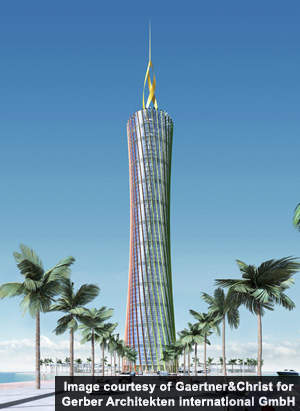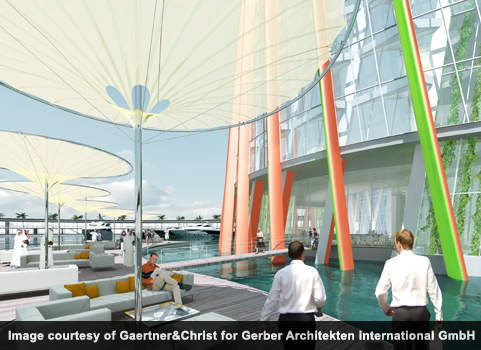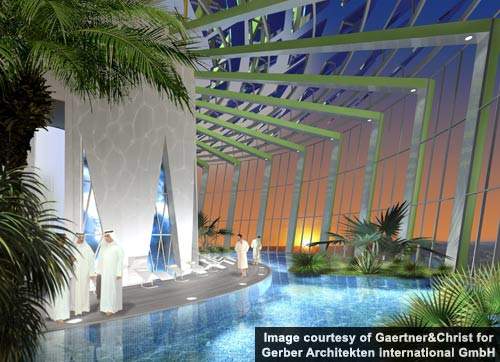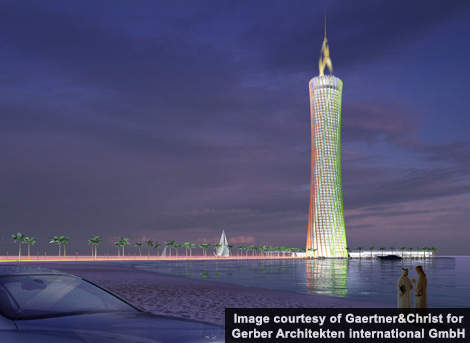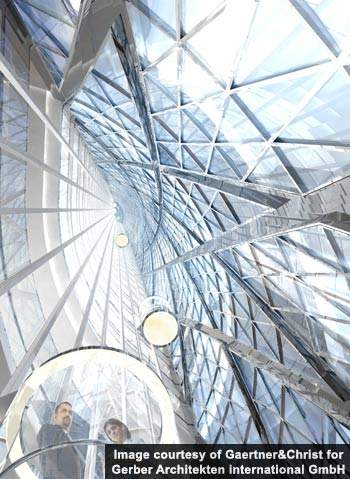Glass constructions can turn into greenhouses for employees but the Burj al-Taqa tower, currently under construction in Dubai, utilises a system of wind thermals and solar panels to create comfortable conditions for employees, while generating 100% of its own power off-grid.
The concept for the 68-storey, 322m (1,056ft) building was completed in 2006-7, and presented to the Ministry of Industry and Commerce in Bahrain and the Arriyadh Development Authority in Riyadh in March 2007. German architect Eckhard Gerber is also working on a zero-emissions office building for Saudi Arabian-capital Riyadh as well as the Bahrain building. When completed, the £200m tower will be the 22nd tallest building in the world and the first to draw all of its energy from renewable sources.
ENVIRONMENTAL CONCERNS
Dubai temperatures can reach 50°C, so the cylindrical shape of the building is designed to minimise exposure of the surface to the sun. All energy is generated from wind turbines and solar panels; the main 60m (197ft) roof-mounted turbine runs off a Darrieus-type rotor, patented design No. 4-06-05-6331.
A giant, rotating shield with an integrated photovoltaic (PV) array – the Solar Shield – covers 60° or one-sixth of the circumference of the tower, from the ground to the roof, and protects the offices from sun exposure.
The windows are protected from indirect sunlight elsewhere on the tower by a mineral coating, which also helps improve the effectiveness of the air conditioning.
There are also two roof-mounted arrays of photovoltaic solar cells covering 15,000m² (161,459ft²) installed on the roof of the Beach Mall next to the tower. An artificial island of solar panels within view of the tower covers 17,000m², (182,986ft²). Natural light is reflected in a cone shape throughout the building from mirrors on the roof.
Solar electricity generated during the day also indirectly powers the tower at night; hydrogen is obtained from sea water through electrolysis, which is powered by excess electricity from the tower. The hydrogen is used to run hydrogen fuel cells, which generate further electricity.
DUBAI ENERGY TOWER CONSTRUCTION
The tower is constructed from cutting-edge vacuum glazed glass, which will be mass- commercialised in 2008, to reduce heat absorption and maximise the available daylight. The glass transmits two-thirds less heat than conventional glazing, and reduces the amount of electricity required to power the air conditioning units. “Such a building has to work like a thermos flask,” says DS-Plan’s energy manager Peter Mösle. “It has to have a cooling effect in the summer and retain heat in the winter.”
The thermal cooling system is entirely based on wind towers traditionally built by wealthy Iranians, called badgirs. These featured louvred openings at the top which drew in cool air high off the ground which then sank and pushed up lighter, hot air, lowering the temperature.
Using a similar convection system, air is sucked in at the base of the skyscraper and expelled from the top of the building. Wind pressure against the walls of the tower also draws stale air out of the offices through thin holes in the façade.
The central atrium and a five-perimeter atria contain transparent ducts that look like plastic cylinders running up through the ceiling on all levels of the building. Architects are considering a plan to suspend hanging gardens in these ducts on thick, steel ropes, turning a functional utility that is usually hidden behind metal or enclosed, into an appealing architectural space. The plants help to keep the air clean and oxygen-rich. The air is pre-cooled naturally by sea water or air channels in the ground.
A double-skin glass façade protects the Solar Shield and helps to clear stale air from the rooms. As an alternative to drafty air currents from air conditioning, water is also pumped round tubes attached to the underside of ceiling slabs on every floor to regulate the temperature. There are three underground cooling units in the cellar which regulate the temperature to 18°C (64.4°F).
The building will have to prove its sustainability over time as many of the materials and techniques used in its construction have not been exhaustively tested, although engineers have simulated conditions using CAD programmes. It is hoped that energy-savings will be 60% more than less-sustainable structures and there are no CO2 emissions. Gerber says of the tower: “There’s nothing like this in the whole world. This kind of accomplishment is very rare.”
BURJ AL-TAQA CONTRACTORS
Almoayed Holdings, who are based in Bahrain are slated to be financing the €300m ($406m) project, by year-end. Stuttgart environmental engineering company DS-Plan, part of the Drees & Sommer group, are building almost all of the building’s entire technological facilities.
Structural engineers are Bollinger + Grohmann Ingenieure (Germany), and fire engineers, Buro Happold / Leeds (UK). Other buildings by Gerber’s office include the King Fahad National Library and a science centre, plus shopping mall in Riyadh.

